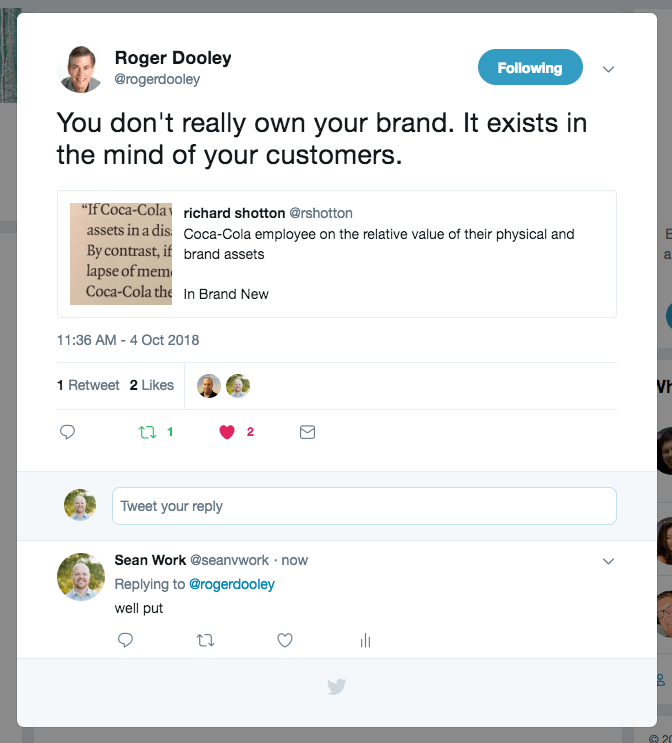Brand.
Not Branding.
Brand.
It’s more than a logo or a slogan. It’s really everything about your company.
And it’s time to flip your mindset about how you do everything from now on.
Let’s get to the point fast: think of Apple, the company.
Intense attention to how their brand is conveyed is present in everything they do. Whether it’s:
- The logo
- The slogan/tagline
- The products
- The packaging
- The Apple Store experience
- The product launches / announcements
- The street address of their headquarters (1 Infinite Loop Cupertino, California 95014)
- The actual headquarters building
Not one decision is glossed over.
Every decision Apple makes as a company most likely starts with the question: How will this affect the brand?
Because everything your prospects and customers experience when they come face-to-face with your brand, builds upon their total impression of your brand.
Their complete experience with your brand will determine:
- Whether or not they will do business with your brand.
- Whether or not they will be a repeat customer.
- How they will tell their friends and family about your brand.
- How easily they will be swayed by another competitor’s offering.
How to Iron Out The Way To Think About Your Brand
I could probably write a book on this particular topic. But, I’m going to do that right now :). Let me at least get you headed in the right direction. I’ll try to boil down the important stuff so you can get started on the right path today.
1. Write Down Your Values
The best way to get you thinking about your company values is to ask this question:
What will you do and NOT do as a company?
And this question:
What guidelines will help you navigate through difficult decisions as a company?
And, finally, this question:
How do your employees know how to act and how to make difficult decisions without being constantly micro-managed?
A good set of company values aligns every employee into individual superstars. A great set of company values that are deeply ingrained in your workforce will solve problems as they arise, treat customers extraordinarily well and instill camaraderie when initiatives are created (or new goals are charted out).
What you’re really trying to do is to create a value system that almost magically turns into company-wide artificial intelligence. Where the values are so strong and well-known, that your workforce not only knows how to do their job extremely well, they know how to grow the company without direction from upper management. Your company would be “self-growing”. That’s the ideal scenario.
Starbucks is another company that appears to have their values down pat, and they somehow got them to be completely instilled in their workforce.
How many times have you had an unpleasant experience interfacing with a Starbucks employee? I know I’ve had very very few.
Everyone seems to be cheery, upbeat and willing to go the extra mile to make sure your experience is wonderful.
So, start thinking about how you can replicate the same type of experience and attitude.
Needless to say, your company values are incredibly important.
They need to be taken uber-seriously. You should actually stop everything you’re doing to boil them down right now if you don’t have any.
And everyone needs to be aware of them. Don’t just post them in the lobby and call it a day. Every employee should be indoctrinated in them.
As a matter of fact, day one for every employee should focus around your company values. Don’t dilute their day with anything else. It should be called “value day” or “value boot camp”.
It shouldn’t be militaristic, scary or a negative experience. It should be fun. At the end of the day, the goal should be that every person ends the day completely stoked that they joined the team. They should leave excited.
Now, there is no iron-clad recipe to create company values. And for good reason: your uniqueness is what is going to set you miles ahead of your competitors.
So spend time crafting them, iterate on them if you have to. If you’re the business leader, this is where you should spend a good chunk of your time.
2. The Way You Hire
Now that you have your brand values down, now you can really hire.
It’s crucial that you build a hiring process that is based on your brand values. You want to seek out people that already share similar values that align with your brand values.
It can be tricky to interview people this way, though.
One of the best ways to do it is to create hypothetical scenarios and create interview questions around them. You want to see how your interviewees answer these type of questions. If their instinctual decisions align with your values, you know you’ve got someone special :).
Don’t create questions where the answer is too easily answered by common sense or in a way where they can easily answer with what you want to hear. You’ll have to work through them a few times to make it hard for them to sniff out the “right answer”.
On a side note – don’t be overly concerned with people’s technical abilities. That’s what most mindless interviewing consists of: can they do the job or not? What you want to be concerned with is: can the do the job well? Can they do the job in the style that your brand does things?
Remember: Anything can be learned. Changing someone’s character is another story.
3. How You Treat Your Employees
The worst companies I’ve ever worked for and that I’ve seen operate treat their employees like sh*t.
They had managers yelling at lower-level employees. People hated working there. The “blame game” is the only thing people end up doing.
The way you treat your employees will determine how they treat your customers.
Never forget this.
My best advice is to follow Richard Branson on Twitter or on Facebook. His management style will rub off on you.
There is a magic in the way he interfaces with people. His “good vibes” translates down through his organization and you end up having a unique and wonderful experience if you’re a Virgin customer.
You’ll never find a frustrated and/or rude agent at the Virgin ticket counter. You might at other airlines ;).
4. Voice and Tone: The Way You Communicate
Your prospects and customers interface with more than your employees. They interface with your words and recorded material as well. That’s why special attention needs to be taken when it comes to creating:
- Website copy
- Advertisement copy
- Printed material
- Sales scripts
- Customer support scripts
You’ll need to develop a voice for your brand. A way you want to sound and feel when people read your website or watch a video you’ve created.
This obviously will take time, maybe years to hone. The important thing is to start thinking about it now, because it’s also a part of how your brand is perceived.
5. Finally, Pay Attention to the Small Stuff
- How’s your design aesthetic? Packaging? User experience? – Everything the customer sees, touches, interfaces with represents your brand. More importantly, it reflects the decision-making at the highest levels and thoughtfulness behind those decisions.
- What kind of experience do customers and prospects have when they call your business phone number?
- What about your office? What’s it like in there? Is it messy and unorganized? Or does it look like you have your you-know-what together?
- How do your employees treat customers and prospects? Are they warm and helpful? Or are they rude and can’t wait to get off work?
I hope this short guide will get you on your way. I know if you’ve really read through this whole guide, internalize it, you might be feeling a little overwhelmed at the moment.
That’s good though! It means it has made an impact.
None of the decisions required to iron out your brand can be taken lightly. That also means you can’t knock it out fast.
Take your time, make this work a priority. Tackle a little bit of it every day.
I guarantee you, thinking about brand is what separates the best from the rest.



